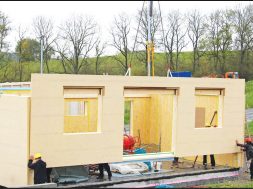Crucial safety protocols and legal frameworks to mitigate risks at construction sites

Leading experts across architectural and electrical sectors have shared their expertise in this industry’s required safety guidelines and regulations and discussed the safety practices and challenges.
The construction industry is widely recognised as one of the most hazardous sectors. However, conscientious developers have always placed a premium on ensuring the safety and efficiency of their operations. This necessitates continuously reassessing processes to maintain the most elevated health and safety benchmarks. Integrating novel safety methodologies, conducting routine gatherings, and deploying advanced protective apparatus and machinery are vital in promptly curbing risks and ensuring safe operations.
According to CR Rajasekar, Senior Manager at Engineers India Limited, taking care of some safety issues at project sites are must. Some standard safety violations are classified as unsafe acts and surroundings at any building site. “Around 88 percent of mishaps are caused by workers acting unsafely, while unsafe working conditions bring on 10 percent of events.” All policies, procedures, training on construction safety, effective monitoring of implementation at the site, and site management oversight are required to eradicate accidents. Also, giving people or teams who excel in implementing a positive safety culture at the job site ongoing support and appreciation will boost morale and increase productivity.
Rajasekar further describes the safety protocols and procedures in more detail, saying that the Job Safety Analysis (JSA), Tools Box Meeting (TBT), and Pre Job Discussion (PDJ) are the tested protocols & Procedures that need to be followed on all construction sites. A well-written JSA aids in identifying the risks and dangers associated with any upcoming actions, and a prior analysis aids in forecasting and the need for preventative action. Tool Box Meetings (TBT) are essential for educating workers and staff about significant construction safety issues, risks and dangers specific to the job at hand, and preventative measures before any work on that day is started.
While discussing the legal framework for building safety, Sneha Gurjar, Director of CEM Engineers, says, “A framework for safety management on construction sites can only be effective if it is followed and regulated with the utmost strictness, not only by the government but also in individual projects on all levels of the chain of command.” This calls for the involvement of the project’s designers, engineers, project managers, contractors, and stakeholders. As seen in India’s large-scale government, urban, or public projects, today’s small-scale initiatives require an equally strict regulatory structure.
According to Rakesh Reddy, Director of Aparna Constructions, The Work Health and Safety (Construction Work) Code of Practice 2015 has been designed to provide complete guidelines to principle contractors and other individuals engaged in construction-related activities. “The code describes the main health and safety requirements for construction work, the range of regulated activities, and the precise roles and responsibilities of persons participating in construction management in compliance with The WHS Act.” The code also requires that all high-risk construction operations be rigorously recorded in safe work procedure statements that pinpoint and eliminate potential hazards. He further emphasises “the architect is a vital figure in both the aesthetic and functional aspects of residential and commercial development” when discussing the architecture of construction for safety”
The director of the House of Kashtee, Srishti Ahluwalia, explains, “Architects often provide the blueprints and specifications for construction projects. They are not heavily involved in the construction itself.” The contractors begin with the plans and use the tools and techniques necessary to finish the job. During construction, the contractor must control dangers. A building’s construction can be more dangerous due to certain design aspects or, occasionally, the absence of other design details. “Construction hazards can be eliminated with carefully considered design elements if contractors, owners, design/build firms, engineers, and architects are given information on how to identify and anticipate them.”
Furthermore, Rakesh asserts, “Best practices in construction materials and structures must be designed to increase efficiency and mitigate risk. Due to its ability to decrease waste and increase production, modular building and prefabrication have become major industry standards. Significantly, most people who use modular construction attest to the effectiveness of its benefits for safety.
Electrical safety
According to Anant, a few contractors are willing to use their site’s safety guidelines despite highlighting the difficulties. Sadly, some places do not provide insurance for site workers and labourers. It demonstrates the workers at the site need more awareness. Construction sites must retain safety records to raise awareness and decrease workplace accidents and illnesses. As part of the risk assessment process, your site operator should have obtained up-to-date maps from the local council that detail where any potentially hazardous wires, cables or electrical equipment are located within the construction site. Again, ensure you have familiarised yourself with these maps before beginning work.
Aniruddh Bapat, Vice President-MEP, TATA Realty and Infrastructure “Electrical safety and personal protective equipment (PPE) must be a core component of the safety plan to be integrated into the overall safety plan for construction sites. This can be done by getting work licences that give all parties involved the information required to ensure safe working procedures are followed.
CR Rajasekar Senior Manager at Engineers India Limited “Tool Box Meetings (TBT) are essential for educating workers and staff about significant construction safety issues, risks and dangers before starting work.”
Sneha Gurjar Director CEM Engineers “To ensure compliance and efficacy, all safety laws, obligations, and duties shall be mentioned in these legal contracts.”
Rakesh Reddy, Director of Aparna Construction, “Best construction materials and structures practices must be designed to increase efficiency and mitigate risk.”
Srishti Ahluwalia, Director of House of Kashtee, “A building’s construction becomes more dangerous with certain design aspects or the absence of other design details.”
Anant Shinde, Director of Sukhkarta Electromech “It is important to identify all of the potential electrical hazards and ensure that suitable control measures are in place to prevent them from causing harm to workers.”
Aniruddh Bapat Vice President-Head MEP, TATA Realty and Infrastructure “All electrical equipment should be inspected and maintained periodically.
66
Cookie Consent
We use cookies to personalize your experience. By continuing to visit this website you agree to our Terms & Conditions, Privacy Policy and Cookie Policy.










